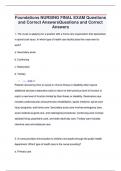Foundations NURSING FINAL EXAM Questions
and Correct AnswersQuestions and Correct
Answers
1. The nurse is applying for a position with a home care organization that specializes
in spinal cord injury. In which type of health care facility does the nurse want to
work?
a. Secondary acute
b. Continuing
c. Restorative
d. Tertiary
✓ ~~~ ANS: C
Patients recovering from an acute or chronic illness or disability often require
additional services (restorative care) to return to their previous level of function or
reach a new level of function limited by their illness or disability. Restorative care
includes cardiovascular and pulmonary rehabilitation, sports medicine, spinal cord
injury programs, and home care. Secondary acute care involves emergency care,
acute medical-surgical care, and radiological procedures. Continuing care involves
assisted living, psychiatric care, and older-adult day care. Tertiary care includes
intensive care and subacute care.
2. A nurse provides immunization to children and adults through the public health
department. Which type of health care is the nurse providing?
a. Primary care
,b. Preventive care
c. Restorative care
d. Continuing care
✓ ~~~ ANS: B
Preventive care includes immunizations, screenings, counseling, crisis prevention,
and community safety legislation. Primary care is health promotion that includes
prenatal and well-baby care, nutrition counseling, family planning, and exercise
classes. Restorative care includes rehabilitation, sports medicine, spinal cord injury
programs, and home care. Continuing care is assisted living and psychiatric care
and older-adult day care.
3. The nurse is trying to determine risk factors unique to home care patients. What
resource should the nurse access?
a. Pew Health Professions Commission
b. The Outcome and Assessment Information Set (OASIS)
c. American Nurses Credentialing Center (ANCC) Magnet Recognition Program
d. Hospital Consumer of Assessment of Healthcare Providers and Systems
(HCAHPS)
✓ ~~~ ANS: B
OASIS (the Outcome and Assessment Information Set), includes a group of
standardized core assessment items for an adult home care patient. OASIS forms
the basis for measuring patient outcomes for the purposes of outcome-based quality.
Data items within OASIS include socio-demographic, environmental, support system,
,health status, functional status, and health service utilization characteristics of a
patient (ResDac, 2016). The OASIS assessment tool was designed to gather the
data items needed to measure both outcomes and patient risk factors in the home
setting. The Pew Health Professions Commission, a national and interdisciplinary
group of health care leaders, recommended 21 competencies for health care
professionals in the twenty-first century. The Hospital Consumer of Assessment of
Healthcare Providers and Systems (HCAHPS) is a standardized survey developed to
measure patient perceptions of their hospital experience. The Magnet Recognition
Program recognizes health care organizations that achieve excellence in nursing
practice.
4. An older-adult patient has extensive wound care needs after discharge from the
hospital. Which facility should the nurse discuss with the patient?
a. Hospice
b. Respite care
c. Assisted living
d. Skilled nursing
✓ ~~~ ANS: D
An intermediate care or skilled nursing facility offers skilled care from a licensed
nursing staff. This often includes administration of IV fluids, wound care, long-term
ventilator management, and physical rehabilitation. A hospice is a system of family-
centered care that allows patients to live with comfort, independence, and dignity
while easing the pains of terminal illness. Respite care is a service that provides
short-term relief or "time off" for people providing home care to an individual who is
, ill, disabled, or frail. Assisted living offers an attractive long-term care setting with an
environment more like home and greater resident autonomy.
5. A nurse is using research findings to improve clinical practice. Which technique is
the nurse using?
a. Performance scores
b. Integrated delivery networks
c. Nursing-sensitive outcomes
d. Utilization review committees
✓ ~~~ ANS: A
Performance improvement activities are typically clinical projects conceived in
response to identified clinical problems and designed to use research findings to
improve clinical practice by applying earned scores. Larger health care systems
have integrated delivery networks (IDNs) that include a network of facilities,
providers, and services organized to deliver a continuum of care to a population of
patients at a capitated cost in a particular setting. Nursing-sensitive outcomes are
patient outcomes and nursing workforce characteristics that are directly related to
nursing care such as changes in patients' symptom experiences, functional status,
safety, psychological distress, registered nurse (RN) job satisfaction, total nursing
hours per patient day, and costs. Medicare-qualified hospitals had physician-
supervised utilization review (UR) committees to review the admissions and to
identify and eliminate overuse of diagnostic and treatment services ordered by
physicians caring for patients on Medicare.




